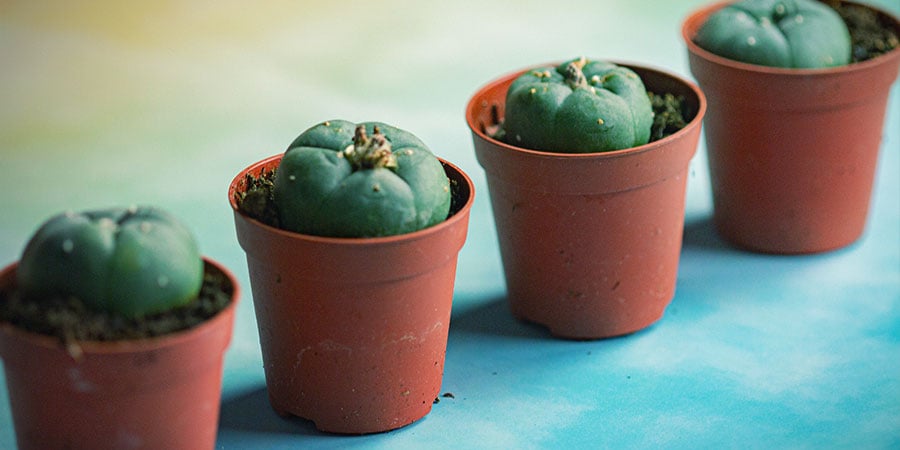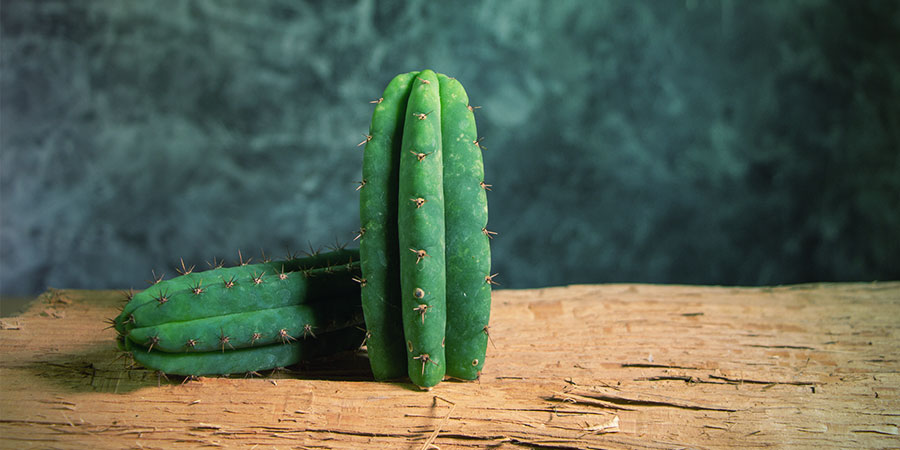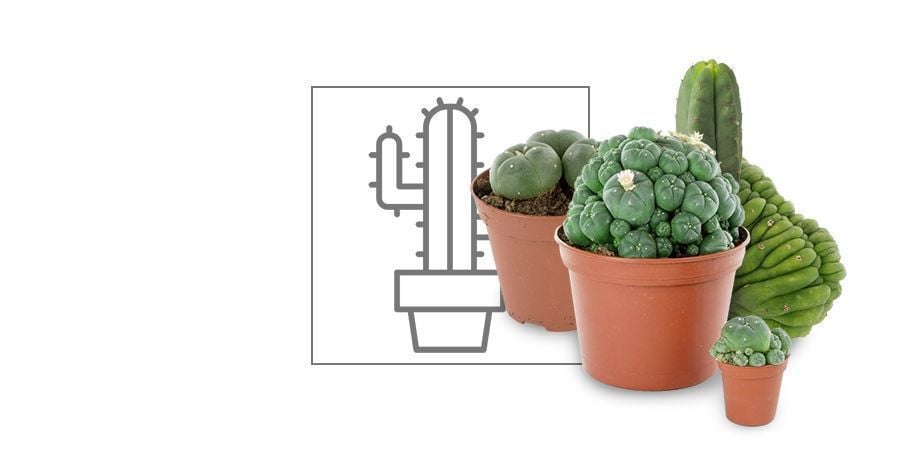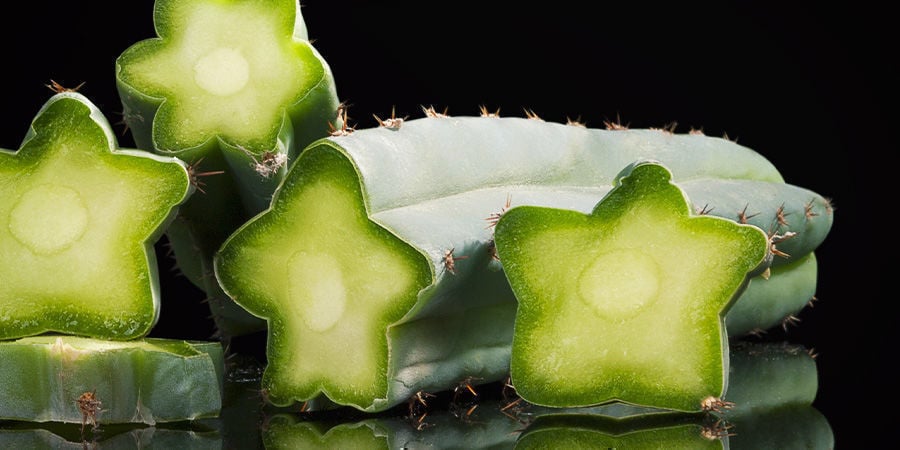
Mescaline Cacti Differences
Mescaline is a psychoactive compound found in several species of cacti. Each species provides its own interpretation of the mescaline experience. How do the effects differ from species to species? Let's find out.
The effects of mescaline differs from species to species and cactus to cactus. Much like cannabis, there is what could be called the 'central signature' effect. Then, from plant to plant, there are nuances and distinctions, modulations and variations. These responses depend on mescaline strength and the inclusion of other exogenous compounds.
The core mescaline effect is a heightened sense of emotional and mental flow. Visual acuity increases and colours become more intense. Natural growing greens fluoresce wildly and the sky ebbs and flows with its own iridescence. There is a profound sense of "being in the now", helped along considerably by a noticeable reduction in mental chatter.
At the psychedelic peak, which can last hours, each person will experience their own unique response to mescaline. Some cruise pleasantly, eyes dilated, gentle smile inspired by personal hallucinations. Some need to move, the intensity overwhelming. When it's like this, go out into nature and feel the silent and magnificent benevolence. Or dance baby, dance!
Members of the Peyote and the Trichocereus family can vary considerably in their interpretation of the central mescaline motif. Plant health plays a part in alkaloid density as well. Well cared for cacti are often more powerful per gram than cacti left to their own devices and they grow larger quicker.
PEYOTE

Peyote is intense and hallucinogenic. The acute visual effects are similar to LSD or DMT. As with all mescaline, it takes a while to come on. Giving hints and traces and body rushes. Then, the floodgates open and you are swept away for up to twelve hours of inverted perspective and hyper coloured reality.
TRICHOCEREUS

The Trichocereus family has several species which all give their own nuance and intensity. Peruvian Torch shares aspects of Peyote with a similar body load and a potency that can sometimes seem unbearable. Maybe the massive fiery orange and maroon spines are a warning. This species is a guaranteed purge followed quickly with rewarding, intense psychedelia.
San Pedro is probably the most common of the Trichocereus cacti. It propagates with very little fuss and grows robustly. Whereas Peyote and Peruvian Torch come on with noticeable verve, San Pedro unobtrusively envelopes. The sky doesn't suddenly start throbbing; after watching the sky throb for an hour, you realize you are tripping balls and wonder when that happened.
Cuzcoensis and bridgesii are two Trichocereus who share a slender form and tiny, but very sharp clusters of spines. They also share a similar effect to San Pedro in that they gently usher you, without you realizing it, into an expanded state of awareness. You are navigating pulsing dayglo coloured psycho-spaces, smiling and completely at ease, unsure of when things got bent.

AFTER EFFECTS
The common after effect of the mescaline experience is an extended feeling of well-being that can last for weeks. There is a greater sense of unification with nature and other animals including humans. Unlike psycho-pharmaceuticals an unforced sense of "all is well with the world" settles in comfortably as do unbidden gentle smiles.
Mescaline bearing plants have been worshipped and used as entheogens for thousands of years by indigenous people for good reason. They can be a sacrament for philosophical or religious experience. They can be a vehicle for personal growth and thereby growth of society. They can also be really good fun, but use them responsibly, okay?
Which Cacti contain mescaline?

Known to date, there are 16 species of cacti that contain mescaline. Hereinafter we provide a list, in which the plants with their current scientific names are listed. Until recently, some cacti were called differently. With these species, we have also given the old name, because until now many cacti are sold under the previously familiar names and also in botanical gardens sold as those. With this overview, we have in any case a valuable tool at hand.
| Current Name | Old Name | Also Known As |
| Aztekium ritteri | ||
| Cereus jamacaru | ||
| Echinopsis lageniformis | Trichocereus bridgesii | Bolivian Torch |
| Echinopsis peruviana | Trichocereus peruvianus | Peruvian Torch |
| Echinopsis pachanoi | Trichocereus pachanoi | San Pedro |
| Echinopsis cuzcoensis | Trichocereus cuzcoensis | |
| Echinopsis deserticola | Trichocereus fulvilanus | |
| Echinopsis macrogona | Trichocereus macrogonus | |
| Echinopsis spachiana | Trichocereus spachianus | |
| Echinopsis strigosa | Trichocereus strigosus | |
| Echinopsis tacaquirensis taquimbalensis | Trichocereus taquimbalensis | |
| Echinopsis terscheckii | Trichocereus terscheckii | |
| Echinopsis valida | Trichocereus validus | |
| Echinopsis werdermanniana | Trichocereus werdermannianus | |
| Eriosyce islayensis | Islaya mino | |
| Gymnocalycium calochlorum | ||
| Gymnocalycium comarapense | ||
| Gymnocalycium gibbosum | ||
| Gymnocalycium horridispinum | ||
| Gymnocalycium netrelianum | ||
| Gymnocalycium riograndense | ||
| Gymnocalycium striglianum | ||
| Gymnocalycium uebelmannianum | ||
| Gymnocalycium valnicekianum | ||
| Gymnocalycium vatteri | ||
| Lophophora williamsii | Peyote | |
| Lophophora diffusa | ||
| Myrtillocactus geometrizans | ||
| Opuntia acanthocarpa | ||
| Opuntia cylindria | ||
| Opuntia basilaris | ||
| Opuntia echinocarpa | ||
| Opuntia ficus-indica | ||
| Opuntia imbricata | ||
| Opuntia spinosior | ||
| Pachycereus gaumeri | Pterocereus gaumeri | |
| Pelecyphora aselliformis | ||
| Pereskia corrugata | ||
| Pereskia tampicana | ||
| Pereskiopsis scandens | ||
| Polaskia chende | ||
| Stenocereus beneckei | ||
| Stenocereus eruca | Machaerocereus eruca | |
| Stenocereus stellatus | ||
| Stenocereus treleasei | ||
| Stetsonia coryne | ||
| Turbinicarpus lophophoroides | ||
| Turbinicarpus pseudomacrochele | ||
| Turbinicarpus pseudopectinatus | Turbinicarpus schmiedickeanus |
CACTI THAT MAY CONTAIN MESCALINE
Matucana madisoniorum is another cactus that may contain mescaline, but has so far not been chemically investigated. We can assume that there are far more cacti, containing the active substance mescaline. It is only a matter of time and research, until other representatives are discovered.
-
 4 min
November 25, 2024
How to Graft Peyote Cactus
While peyote is fairly easy to grow, it takes many years to reach maturity. Grafting can significantly speed up growth—tripling or even quadrupling the rate of maturation! Keep reading to find out...
4 min
November 25, 2024
How to Graft Peyote Cactus
While peyote is fairly easy to grow, it takes many years to reach maturity. Grafting can significantly speed up growth—tripling or even quadrupling the rate of maturation! Keep reading to find out...
-
 5 min
November 27, 2019
How To Grow Your Own Mescaline Cactus From Seed
Mescaline is a natural psychedelic produced by several types of cactus including peyote, San Pedro, and the Peruvian torch. These cacti are easy enough to grow, even if you don't have a lot of...
5 min
November 27, 2019
How To Grow Your Own Mescaline Cactus From Seed
Mescaline is a natural psychedelic produced by several types of cactus including peyote, San Pedro, and the Peruvian torch. These cacti are easy enough to grow, even if you don't have a lot of...
-
 2 min
November 15, 2014
The Long-Term Effects of Peyote Use on the Brain
Peyote has been used for entheogenic practices for thousands of years - but what effect does such use have on the brain?
2 min
November 15, 2014
The Long-Term Effects of Peyote Use on the Brain
Peyote has been used for entheogenic practices for thousands of years - but what effect does such use have on the brain?











 United States
United States








